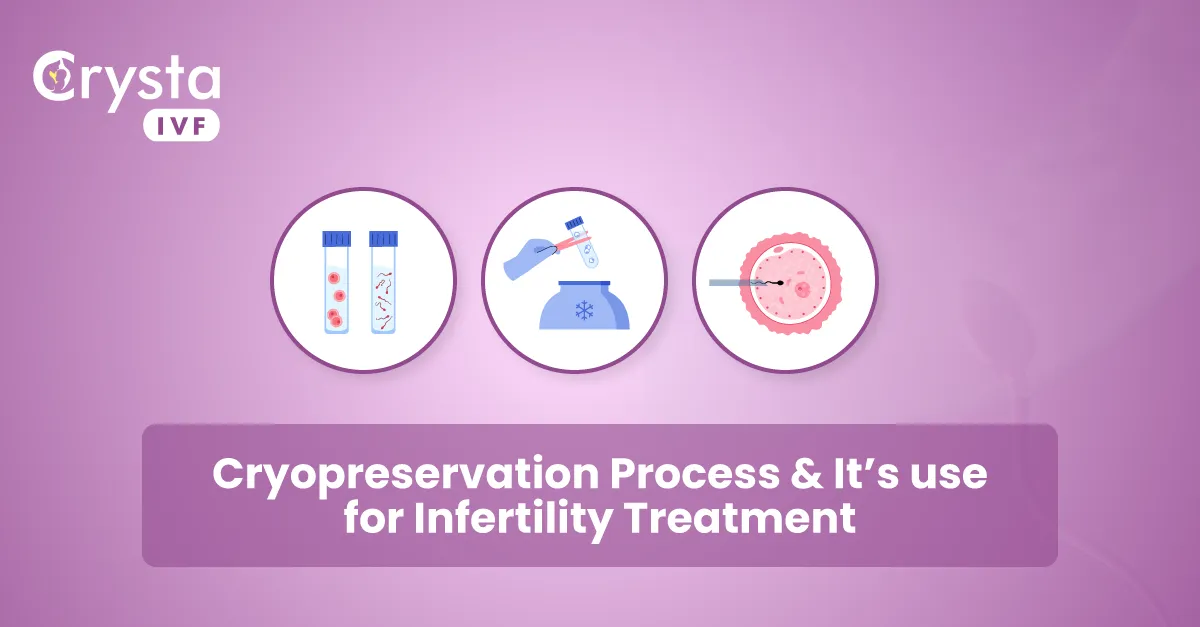Cryopreservation is an age-old technique of preserving biological materials with its origin back in 2000 B.C.
Overview:
Cryopreservation, or the process of preserving biological specimens at significantly low temperatures (Liquid Nitrogen Temperature of -196°C), is helpful in medical research, zoology, biotechnology, botany, clinical medicine, and Infertility Treatment.
During the procedure, the experts control the metabolism of the stored cells through ultralow temperatures or the freeze-thaw process. It restricts the death and damage of the cells during the preservation.
The doctors and researchers use liquid nitrogen and dry ice for cryopreservation. Cryopreservation is a multi-stage procedure and has several applications. Continue with a good read for in-depth acknowledgments of the same.

Cryopreservation Process:
Cryopreservation involves five significant steps for its completion. Below-mentioned is the step-wise description.
Step-1: Harvesting or Specimen Selection: For cryopreservation of biological specimens, the specialists consider multiple things like volume, density, morphology, ph, and other physical parameters to store only high-quality samples.
Step-2: Adding Cryo-Protectant: After harvesting, the next step is to add cryoprotective agents. These protectants like glycerols, salts, sugars, FBS, and glycols help slow down the cooling rate. Not adding the protectants while Egg Freezing or sperm cryopreservation might lead to its crystallization.
Step-3: Freezing of Specimen: Irrespective of the purpose of cryopreservation, be it research or infertility treatment, protecting the specimen is essential. Different freezing techniques are applied to the specimen to protect the biological samples from any damage.
Step-4: Storage: Most of the samples are immersed in liquid nitrogen or dry ice below -80°C for a minimum of 5 to 24 hours before transferring them to storage vessels.
Step-5: Thawing: Last but not least, the final step of cryopreservation involves thawing. It consists in heating the samples to control cooling and cell damage caused due to crystallization.
Today, Cryopreservation is the most common and useful process while treating infertility. However, the procedure remains the same irrespective of the purpose of its application.
Cryopreservation For Infertility Treatment:
In Assisted Reproductive Technologies, the doctors use cryopreservation for both male and female infertility treatment. Here is the list of how cryopreservation is helpful for infertility treatment.
Cryopreservation of Embryos: If a woman cannot conceive naturally due to ovulation issues, the doctors force egg stimulation, and then these eggs are fertilized in the labs. The higher the number of embryos, the higher are the chances of pregnancy.
However, it’s not possible to transplant all the embryos together. So, to conserve the embryos for future use, fertility specialists use Embryo Cryopreservation. The preserved embryos are helpful for the successive IVF cycles.
Sperm Cryopreservation: At times, it is impossible to get fresh semen for assisted fertilization. In such a case, the doctors use Cryopreservation of Sperms which helps future conception. It is possible to store, freeze, and deposit sperm in cryobanks.
However, the sperms remain healthy only for less than a year. IVF and other infertility treatments are possible only through fresh semen retrieval without cryopreservation.
Oocyte Cryopreservation: During the vitrification method, the eggs freeze rapidly. It constraints the proper fertilization and transplantation process during In Vitro Fertilization
For the use of eggs properly for infertility treatment, the cryoprotectants help to seize ice crystal formation.
Also, if the egg has any additional water content, it’s possible to remove it through sucrose during Ovarian Cryopreservation.
In this process, the egg is put into an antifreeze cryoprotectant for a few seconds and then transferred to liquid nitrogen.
After the thawing process, either the egg is used for fertilization.
Cryopreservation For Clinical Application:
The advancement of the medical field entirely depends on advanced research and study. Cryopreservation has helped to reach multiple clinical conclusions and the studies are ongoing.
Here is the list of a few of the Clinical Applications of Cryopreservation.
Stem Cell Cryopreservation: Stem cell research reveals the use of stem cells for the treatment of severe medical conditions in patients like:
- Transplantation
- DNA Related Issues
- Alkylating Agent Therapy
- Issues Related to Menstrual Cycle
- Pelvic Problems
- Neurological Disorders, and more
Stem Cell Cryopreservation help to keep the stem cells healthy for a minimum of eleven years. Not preserving the stem cells in liquid nitrogen or cryobanks reduce the quality of stem cells and make them useless for future use.
Cryopreservation of Decellularized Oesophagi: Long-term Cryopreservation of Decellularized Oesophagi is useful for tissue engineering. The efficient preservation of oesophagi helps with necessary clinical translational research.
Preserving the oesophagus helps in the future replacement of the oesophagus.
It helps deal with extensive throat and stomach infection issues in the future. Not dealing with the esophagus infections on time might lead to severe allergies.
Cryopreservation is highly effective in preserving biological samples like organelles, tissues, cells, and avoiding the degradation of necessary living cells.
Moreover, the application of Cryopreservation For Infertility Treatment is highly helpful. Without the egg freezing process, conceiving with ART like IUI, IVF wouldn’t have been possible.
Crysta IVF is continuously progressive in detailing the benefits of cryopreservation and other such processes that support Assisted Reproductive Technologies. Reading such information can keep you updated about the terms & procedures that are an integral part of Infertility Treatments.
The lesser the confusion a couple has about medical terminologies, the higher is their trust in the treatment.
Cryopreservation Cost in India:
The Cryopreservation Cost entirely depends on:
- The cells & tissues you preserve
- Duration for which you preserve
- Choice of laboratories
- Effectiveness of the procedure, and
- Location
Say, for example, the Embryo Freezing Cost varies between 10,000 to 30,000 per month. So, the total cost of freezing depends on the duration between your embryo freezing and the IVF cycle.
Based on the use and application of cryopreservation, it’s possible to get a personalized quotation from the laboratories. However, you should ensure to get from a trusted laboratory to get transparent pricing and avoid any hidden costs.
Concluding Lines:
Cryopreservation is one of the root techniques that help conceive even above 35 years of age. Also, we can say that with embryo cryopreservation one can conceive with low-quality or limited ovarian reserve, and male infertility issues.
Crysta IVF fertility experts are continually progressive in helping couples to start their parenthood journey & cryopreservation is a necessary step for ART procedures.
For more information regarding infertility, infertility treatments, medical procedures, and customized consultancy; stay tuned with us.




